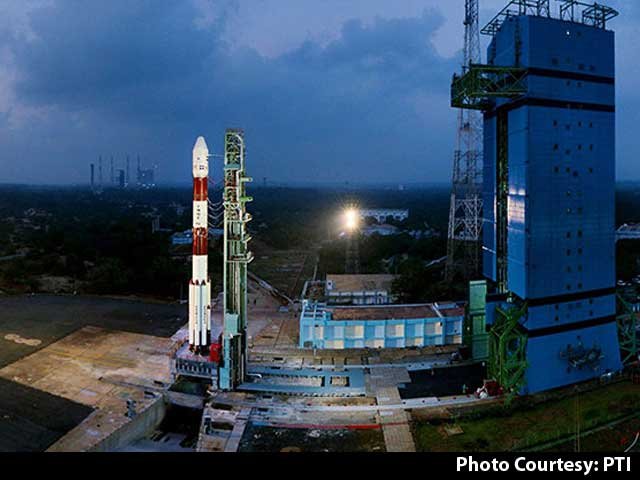ISRO had brushed off speculations of sabotage after the last satellite launch failure. Scientists said a tiny but vital equipment of the rockethad failed, due to which its protective heat shield could not be separated. Story Highlights
Story Highlights
Surveillance satellite from "Cartosat 2" will watch hostile neighbours
710-kg earth observation satellite is the third in "Cartosat 2" series
Launch of IRNSS-1H satellite in August last year had failed
Space agency ISRO this morning successfully sent up a rocket carrying India's 100th satellite along with 30 others, four months after failed launch. The Polar Satellite Launch Vehicle or PSLV lifted off at 9.29 am from Sriharikota in Andhra Pradesh and a key component that had failed in August worked this time, causing scientists to gasp in relief at having crossed a major hurdle. The lift-off was postponed by a minute because of fear of collision with space debris. The last launch of IRNSS-1H - India's first privately built satellite -- on August 31 last year had failed because of a freak accident. This is the 42nd flight of the PSLV.
Top Stories
Top Videos
India
Latest News
Live TV
World
News Beeps
Tech News
Opinion
Offbeat
Cities
Movies
Trending
Top Photos
Advertisement
HomeAll India
4 Months After Failed Bid, ISRO Launches 100th Satellite: 10 Facts
All India Reported by Pallava Bagla, Edited by Anindita Sanyal
ISRO had brushed off speculations of sabotage after the last satellite launch failure. Scientists said a tiny but vital equipment of the rockethad failed, due to which its protective heat shield could not be separated.
Updated : January 12, 2018 09:52 IST
Story Highlights
Surveillance satellite from "Cartosat 2" will watch hostile neighbours
710-kg earth observation satellite is the third in "Cartosat 2" series
Launch of IRNSS-1H satellite in August last year had failed
Space agency ISRO this morning successfully sent up a rocket carrying India's 100th satellite along with 30 others, four months after failed launch. The Polar Satellite Launch Vehicle or PSLV lifted off at 9.29 am from Sriharikota in Andhra Pradesh and a key component that had failed in August worked this time, causing scientists to gasp in relief at having crossed a major hurdle. The lift-off was postponed by a minute because of fear of collision with space debris. The last launch of IRNSS-1H - India's first privately built satellite -- on August 31 last year had failed because of a freak accident. This is the 42nd flight of the PSLV.
Here are 10 facts about the ISRO launch:
The 30 other satellites include two other satellites from India and 28 satellites from six countries -- Canada, Finland, France, Korea, the United Kingdom and the United States.
Scientists said the mission is a unique one, since the satellites will be launched in two orbits. Thirty of the satellites will be launched in an orbit 550 km about, and one 359-km above the Earth.
This will be done through what scientists call the "multiple burn technology" under which the rocket's engine is switched off and then switched on to control its height.
The whole process of placing the satellites in two orbits will take 2 hours 21 minutes -- the longest so far. The 28-hour countdown for the launch of the PSLV started at 5.29 am on Thursday.
The 710-kg earth observation satellite the PSLV is carrying the third in the Cartosat 2 series. The last satellite of the series had been launched successfully in June 2016.
ISRO had brushed off speculations of sabotage after the last satellite launch failure. Scientists said a tiny but vital equipment of the rocket had failed, due to which its protective heat shield could not be separated.
The heat shield of a satellite is meant to protect it from the heat generated by the friction against atmosphere during take-off.
The launch became necessary after three atomic clocks of one satellite started malfunctioning. Atomic clocks provide navigational data, and they are crucial for a Global positioning system.
NAViC, a system of seven satellites, powers India's powerful homegrown Global Positioning System.
ISRO's workhorse PSLV rocket weighs nearly 320 tonnes and stands up to 44.4 meters, equivalent to a 15-storey building.
Good imformation......jaiho india
Tnq u bro
Well done! This post has received a 100.00 % upvote from @litasio thanks to: @jvsmsjeevitesh. Whoop!
If you would like to delegate to the @LitasIO you can do so by clicking on the following link: 10SP
This post has received a 3.11 % upvote from @drotto thanks to: @jvsmsjeevitesh.
@drotto i had sent 0.45 but u gave me up vote of 0.1 ist not good
Revert me soon UV and follow.
Hai
What did happend?
https://www.facebook.com/jvs.jeevitesh